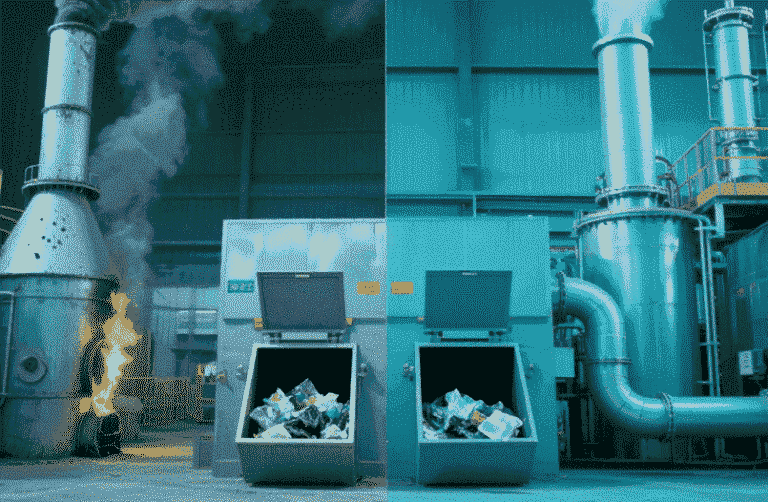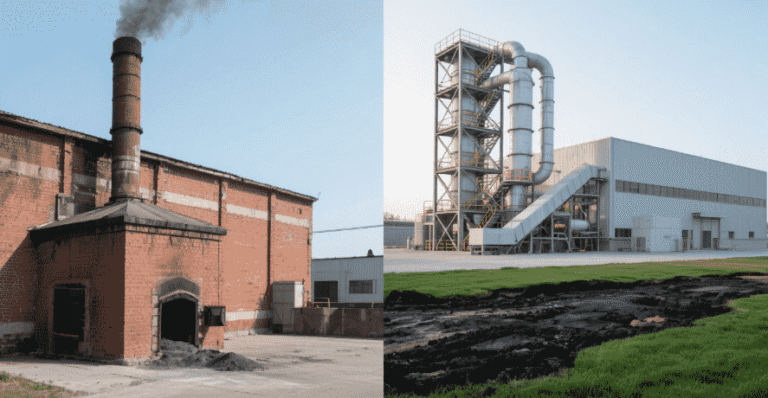Welcome to My Blog! 🌟
I’m so glad you’re here! Before we jump into the exciting content, I’d love for you to connect with me on my social media platforms. It’s where I share extra insights, interact with our amazing community, and post regular updates. Here’s how you can join the conversation:
📘 Facebook: Follow me on Facebook for more updates
Now, let’s dive into the journey ahead. I hope you find everything here both engaging and valuable. Together, let’s explore, learn, and grow! 🚀
Table of Contents
Introduction

In the rapidly evolving healthcare industry, managing medical waste effectively and safely has become a critical concern. A medical waste incinerator plays a pivotal role in this process, ensuring hazardous medical waste is disposed of in a manner that protects both public health and the environment. Modern medical waste incinerators have transformed traditional waste disposal methods with advanced technologies, delivering significant positive impacts.
Medical waste incinerators are specially designed systems that combust medical waste at high temperatures, reducing it to ash and gases that are easier to manage and less harmful to the environment. From hospitals to research labs, the use of these incinerators has become an industry standard worldwide. This blog will explore five positive impacts of modern medical waste incinerators, highlighting their benefits, operational efficiencies, and environmental advantages.
Positive Impact 1: Enhanced Environmental Safety with Modern Medical Waste Incinerators
One of the most profound benefits of using a modern medical waste incinerator is its significant contribution to environmental safety. In the past, incineration systems were notorious for emitting harmful pollutants into the atmosphere. These pollutants included dioxins, furans, heavy metals, and fine particulate matter that posed serious threats to public health and environmental sustainability.
Modern medical waste incinerators, however, have undergone a technological transformation. They are now equipped with advanced features designed to mitigate these negative environmental effects. The latest models incorporate state-of-the-art emission control systems that meet or exceed the strictest international environmental regulations.
Advanced Emission Control Technologies
Today’s incinerators utilize a combination of sophisticated technologies such as baghouse filters, wet scrubbers, activated carbon injection, and catalytic converters. These mechanisms work in tandem to trap and neutralize harmful particles before they can escape into the air. For example, baghouse filters capture fine particulates, while activated carbon targets heavy metals and dioxins.
Furthermore, these emission controls are monitored in real-time, allowing operators to make immediate adjustments to ensure consistent compliance with air quality standards. This significantly lowers the risk of air pollution and its associated health problems.
Reduced Toxic Residues and Byproducts
Beyond emissions, modern incinerators also address another critical environmental concern: residual waste. Traditional incineration systems often left behind ash laden with toxic substances, which had to be carefully managed in hazardous waste landfills.
By contrast, a modern medical waste incinerator operates at higher temperatures with improved combustion efficiency, which reduces both the volume and toxicity of residual ash. This not only decreases the burden on landfills but also minimizes the risk of soil and groundwater contamination—common issues associated with poorly managed medical waste disposal.
In essence, the use of modern incinerators is a proactive step toward sustainable healthcare waste management. By drastically reducing both airborne emissions and toxic residues, they play an essential role in protecting ecosystems and public health.
Positive Impact 2: Improved Operational Efficiency of Medical Waste Incinerators
Another significant advantage of deploying a modern medical waste incinerator is the boost in operational efficiency. Efficiency is not just about speed; it also encompasses fuel consumption, automation, waste processing capacity, and overall system reliability. Healthcare facilities that operate these advanced systems experience tangible benefits in their daily operations.
Smart Design for Optimal Performance
Modern incinerators are built with efficiency in mind. Their combustion chambers are specially engineered to achieve complete thermal destruction of waste at higher speeds. This means that more waste can be processed in less time, without compromising on safety or emission standards.
Moreover, the design of these systems includes optimized air flow regulation, pre-heated combustion air, and secondary burn chambers, which together improve fuel utilization and ensure that waste is completely incinerated with minimal residue.
Automation and Real-Time Monitoring
Contemporary incinerators are equipped with smart automation systems that manage critical operational parameters such as temperature control, waste feed rate, and air-to-fuel ratios. These systems continuously monitor performance and make real-time adjustments, reducing human error and enhancing consistency.
Real-time diagnostic tools and performance analytics allow for preventive maintenance, minimizing unplanned downtime and extending the life of the equipment. Operators receive alerts if any parameter deviates from the optimal range, enabling swift corrective action.
Cost Savings Through Improved Efficiency
Because of these technological innovations, modern medical waste incinerators consume significantly less fuel compared to their outdated counterparts. They also require fewer manual interventions, reducing labor costs. These savings add up over time, making the investment in a high-efficiency incinerator a financially sound decision for healthcare institutions.
In summary, improved operational efficiency not only enhances the day-to-day performance of medical waste disposal but also contributes to long-term cost-effectiveness and sustainability for healthcare providers.
Positive Impact 3: Increased Safety for Medical Waste Incinerator Operators and Nearby Communities

Operating a medical waste incinerator involves inherent risks, but modern Operating a medical waste incinerator involves managing potentially hazardous materials and high-temperature combustion systems. In earlier systems, safety protocols and technology were often inadequate, exposing operators and nearby residents to considerable risks. Fortunately, modern medical waste incinerators are designed with safety as a top priority, incorporating multiple layers of protection to mitigate these risks.
Advanced Safety Features for Operator Protection
Today’s incinerators come with fully sealed combustion chambers, which prevent the escape of harmful gases or infectious aerosols during operation. This is critical when dealing with waste such as used syringes, contaminated dressings, and expired pharmaceuticals.
Automated systems now handle many of the most dangerous steps in the process. For example, automated loading and unloading mechanisms reduce the need for manual handling of hazardous waste. This limits the exposure of workers to biohazards and minimizes the chance of accidental injuries.
Real-time monitoring systems also play a key role in ensuring safety. These systems track parameters such as chamber pressure, internal temperature, and gas composition, and automatically trigger alarms or shutdowns if unsafe conditions are detected.
Emergency Protocols and Fail-Safe Mechanisms
Modern medical waste incinerators are built with comprehensive emergency shutdown features. In the event of a malfunction—such as a gas leak or excessive temperature spike—the system can immediately cease operation and initiate cooling and containment procedures. These fail-safes are essential for preventing fires, explosions, or toxic gas releases.
Community Health and Environmental Justice
Safety considerations extend beyond the facility itself. By minimizing emissions and preventing leaks, modern medical waste incinerators reduce the environmental burden on surrounding communities. This is particularly important in densely populated or environmentally sensitive areas.
Healthcare facilities that use advanced incinerators demonstrate their commitment not only to regulatory compliance but also to the wellbeing of the public. Transparent operation, supported by emissions reporting and community engagement, helps maintain public trust and addresses concerns about the health impact of waste incineration.
In conclusion, safety is no longer a secondary concern—it is a built-in feature of every modern medical waste incinerator. These advancements protect the people who operate the equipment and reassure the communities that depend on safe and sustainable healthcare services.
Positive Impact 4: Versatility and Customization of Modern Medical Waste Incinerators
Modern medical waste incinerators offer remarkable adaptability, allowing facilities to handle a wide variety of medical waste types efficiently.
Customizable Features Include:
- Multi-chamber designs for different waste categories
- Compatibility with infectious, pharmaceutical, and pathological waste
- Adjustable burn rates and residence times based on waste composition
This versatility ensures that medical waste incinerators meet the specific needs of different healthcare settings, from small clinics to large hospitals.
Positive Impact 5: Regulatory Compliance and Reputation Enhancement with Medical Waste Incinerators

In many regions, strict regulations govern medical waste disposal. Utilizing a modern medical waste incinerator helps facilities comply with these laws and avoid costly fines or shutdowns.
Benefits of Compliance:
- Avoidance of legal liabilities
- Positive public relations by demonstrating environmental responsibility
- Qualification for certifications and accreditations
Compliance also ensures that healthcare providers maintain trust with patients and stakeholders, reinforcing their reputation as responsible organizations.
Table: Comparison of Key Features in Modern Medical Waste Incinerators
| Feature | Traditional Incinerator | Modern Medical Waste Incinerator | Benefit |
|---|---|---|---|
| Emission Controls | Basic or absent | Advanced scrubbers, filters, and monitors | Significant reduction in air pollution |
| Operational Efficiency | Low to moderate | High with automated controls | Reduced fuel costs and downtime |
| Safety Measures | Limited | Sealed chambers, alarms, automated stops | Increased operator and community safety |
| Waste Compatibility | Limited to certain waste types | Handles infectious, pharmaceutical, and pathological waste | Enhanced versatility |
| Regulatory Compliance | Often non-compliant | Fully compliant with international standards | Avoidance of fines and reputational gain |
Conclusion
Modern medical waste incinerators represent a leap forward in healthcare waste management, combining environmental safety, operational efficiency, and regulatory compliance. For medical facilities aiming to enhance their waste disposal practices, investing in these advanced systems ensures long-term benefits not only for the environment but also for the health and safety of workers and surrounding communities.
By embracing the technological advancements of modern medical waste incinerators, healthcare providers contribute positively to a sustainable and safer future.
FAQ
What types of medical waste can a modern medical waste incinerator handle?
Modern medical waste incinerators are designed to process a wide range of medical waste, including infectious waste, pharmaceutical products, pathological waste, and sharps.
How do medical waste incinerators ensure environmental safety?
They incorporate advanced emission control technologies such as scrubbers and filters to minimize harmful pollutants released during combustion.
Are modern medical waste incinerators expensive to operate?
While initial costs may be higher, modern incinerators are more fuel-efficient and require less maintenance, resulting in cost savings over time.
How can medical facilities maintain compliance with waste disposal regulations?
Using certified modern medical waste incinerators and following proper operating procedures helps ensure compliance with local and international regulations.
What safety features protect operators of medical waste incinerators?
Features like sealed combustion chambers, real-time monitoring, and automated shutdown systems help protect operators from exposure to harmful substances.






